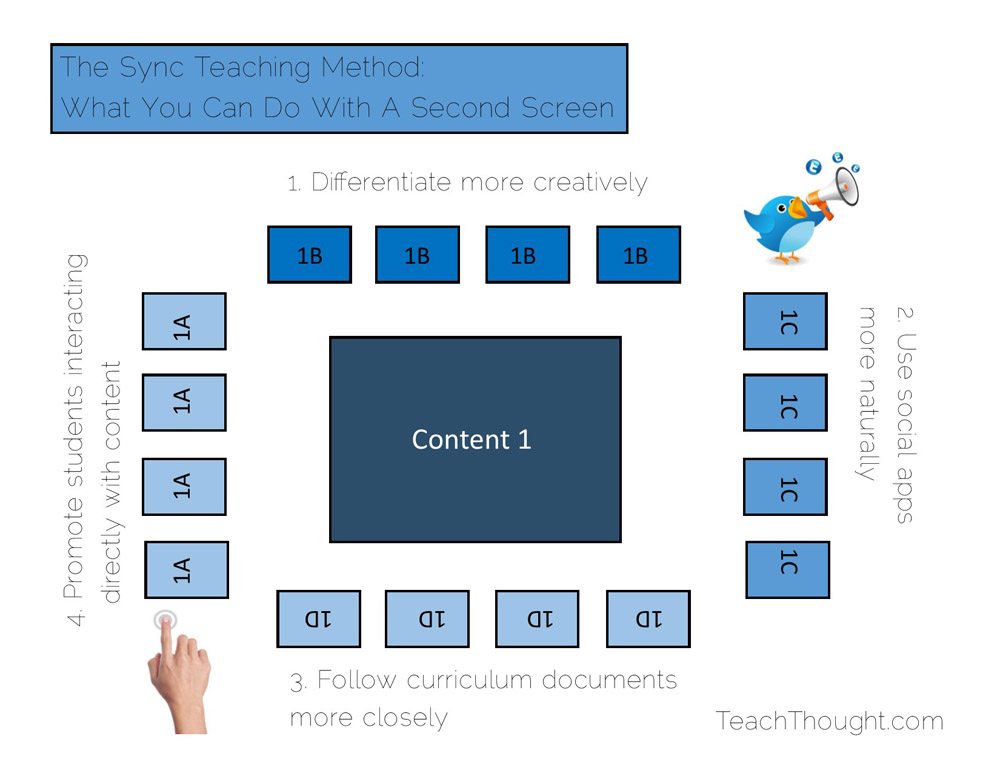
What Is The Sync Teaching Method?
by Terry Heick
The definition of second screen learning is roughly what it sounds like it might be–learning through a second screen. This doesn’t necessarily mean, however, that students are on their own, nor even that every student has to have their own device. Let’s back up for a moment and take a look at the big picture of learning.
Learning is about students interacting with and creating new ideas. For decades, the ‘create’ part has been mostly mute, saved for end-of-the-unit projects or writing prompts. And the interaction part was often missing as well. Interaction is possible with teachers and textbooks as well as it is with apps and tablets, but not on the same scale, with the same degree of personalization, or the same engaging form factors.
See also How To Use The Sync Teaching Model
The Difference Between 1:1 & Second Screen Learning
In a 1:1 environment, every student has their own device–which opens things up considerably. Second screen learning environments can also see every student having their own device–or even one per group. The difference is a matter of syncing. In second screen learning classrooms, the teachers and students are ‘sync’d’ content-wise with one another, while still having the tools, learning strategies, freedom, and space to clarify, extend, create, or connect the learning.
Take the metaphor of the teacher as a conductor, and the students as members of the symphony. Roughly, that’s what second screen learning implies–a group of students creating their own music, but still following the teacher as a guide. The difference is that here, the teacher is the ‘first screen’–the Sync Point. In this role, they choose what, when, and how the students sync with the primary screen, or the teacher themselves.
A Clarifying Image Of The Sync Teaching Method
The image below hints at this, where the teacher is delivering ‘Content 1,’ and each student or group of students are then accessing 1A, 1B, 1C, and so on, respectively. Whether this is done in 4 groups with 4 tablets, or 28 individual students in 1:1 or BYOD classrooms, the big idea is the same: students accessing (or creating) personalized content while the teacher guides and facilitates the core of the lesson.
A neat middle ground between self-directed learning and sage-on-stage, yes? So what are some of the benefits for you as a teacher?
The Benefits Of Sync Teaching: A Second Screen Learning Model
1. You can differentiate more creatively
In the Sync Teaching approach, teachers have the ability to differentiate due to the sheer abundance of engaging and flexible learning resources, from learning simulations to YouTube channels, blogs, social media platforms, and more.
If you think of differentiation as offering different content, processes, products, or learning environment based on readiness or interest, the more diverse those processes, products, environment, or that content, the more creative you can get as a teacher. Here, students are only required to ‘sync’ with your standard, or topic, essential question, or whatever.
As the teacher, you choose the central theme, and they make their own pathways in pursuit.
2. Students can use social apps more naturally
Using social apps in sync teaching, students can interact with one another using their ‘digital voice.’ They can also ping relevant networks and communities, peers in other schools. community and organization leaders, or even content experts.
They can also curate their thinking and mingle using backchannel discussions on twitter or instagram. Could the get off-task and distracted? Of course, but that’s not new. And it’s also easier to track by those same networks, peer groups, and even families.
3. You can follow curriculum documents more closely
This is probably the biggest draw of syn teaching/second screen learning for many teachers: the ability to stick to necessary curriculum documents. While many teachers want to let students innovate and direct their own learning, this is often at odds with the demands of assessment requirements, and local school and district concerns.
How can second screen learning help here? By allowing the teachers to choose the central theme–or Sync Point–while still offering students room to create, find their own resources, clarify their understanding, etc.
In this way, it’s a kind of blended approach to tablets–that is, a blend of find-your-own-pathway-to-whatever-you-find-interest and do-this-then-this-then-this-because-I-said-so. Students can have their learning extended by teachers, or extend and create it themselves parallel to the teacher. They can follow their curiosity while the teacher remediates, or add their own voice and choice to the lesson with their ‘digital voice.’
4. Sync Teaching promotes students interacting directly with content
As opposed to traditional 1:1 classrooms, sync teaching/second screen learning is less ‘open’; compared to traditional classrooms, it’s more so. Somewhere in the middle, second screens allow students to access instead of watch; respond instead of listen; create instead of watch others create. It also puts every student on the clock to produce something.
In a second screen classroom, every student has a digital instrument to make sound, but they most due so with some kind of pace, rhythm, or pattern set by the teacher–who, for all the technology in the world, is almost always the most powerful learning resource a student has access to.
This post was written in 2017 and updated several times, most recently in April 2022
